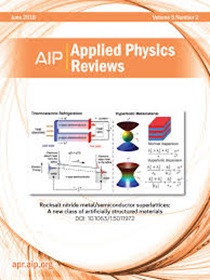Recent advances in fluidic neuromorphic computing
IF 11.6
1区 物理与天体物理
Q1 PHYSICS, APPLIED
引用次数: 0
Abstract
Human brain is capable of optimizing information flow and processing without energy-intensive data shuttling between processor and memory. At the core of this unique capability are billions of neurons connected through trillions of synapses—basic processing units of the brain. The action potentials or “spikes” based temporal processing using the regulated flow of ions across ion channels in neuron cells allows sparse and efficient transmission of data in the brain. Emerging systems based on confined fluidic systems have provided a framework for a new type of neuromorphic computing with lower energy consumption, hardware-level plasticity, and multiple information carriers that emulate natural processes and mechanisms of human brain. These systems mimic neuronal architectures by harnessing and modulating ion transport along artificial channels. The spikes-induced ion-to-surface interactions within these fluidic systems enables the control of ionic conductivity to achieve synaptic plasticity for the realization of brain-inspired functionalities such as memory effect and signal transmission. Herein, this review provides an overview of recent advances in fluidic devices such as memristors and other computing components, covering their basic operations, materials and architectures, as well as applications in neuromorphic computing. The review concludes with a brief outline of the challenges that these emerging technologies face and an outlook for the development of fluidic-based brain-inspired computing.流体神经形态计算的最新进展
人脑能够优化信息流和处理,而无需在处理器和存储器之间进行能量密集型的数据传输。这种独特能力的核心是数十亿个神经元通过数万亿个突触连接在一起——这是大脑的基本处理单元。动作电位或“尖峰”为基础的时间处理利用调控的离子流通过离子通道在神经元细胞允许稀疏和有效的数据传输在大脑中。基于受限流体系统的新兴系统为新型的神经形态计算提供了一个框架,该系统具有低能耗、硬件级可塑性和模拟人类大脑自然过程和机制的多种信息载体。这些系统通过利用和调节沿人工通道的离子传输来模拟神经元结构。在这些流体系统中,尖峰诱导的离子与表面的相互作用使离子电导率的控制能够实现突触的可塑性,从而实现大脑激发的功能,如记忆效应和信号传输。本文综述了忆阻器等流体器件和其他计算元件的最新进展,包括它们的基本操作、材料和结构,以及在神经形态计算中的应用。本文最后简要概述了这些新兴技术面临的挑战,并展望了基于流体的脑启发计算的发展前景。
本文章由计算机程序翻译,如有差异,请以英文原文为准。
求助全文
约1分钟内获得全文
求助全文
来源期刊

Applied physics reviews
PHYSICS, APPLIED-
CiteScore
22.50
自引率
2.00%
发文量
113
审稿时长
2 months
期刊介绍:
Applied Physics Reviews (APR) is a journal featuring articles on critical topics in experimental or theoretical research in applied physics and applications of physics to other scientific and engineering branches. The publication includes two main types of articles:
Original Research: These articles report on high-quality, novel research studies that are of significant interest to the applied physics community.
Reviews: Review articles in APR can either be authoritative and comprehensive assessments of established areas of applied physics or short, timely reviews of recent advances in established fields or emerging areas of applied physics.
 求助内容:
求助内容: 应助结果提醒方式:
应助结果提醒方式:


